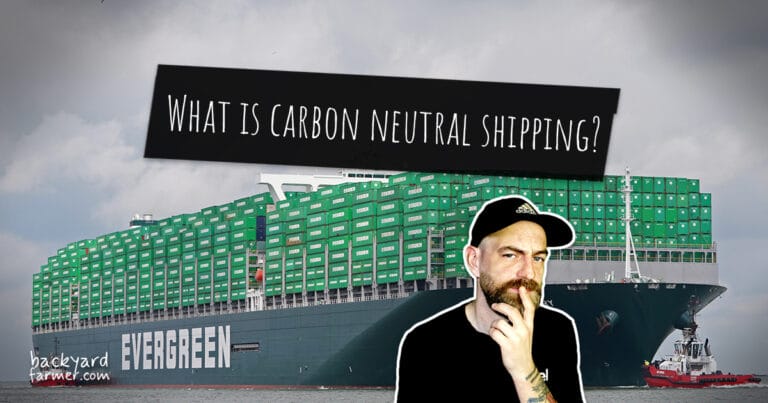Table of contents
- What is Carbon Neutral Shipping?
- What Does Carbon Neutral Shipping Actually Mean?
- Carbon Offsetting Explained
- How Does Carbon Neutral Shipping Work?
- Packaging, Routes & Emissions
- Examples of Carbon Neutral Shipping Companies
- Does Carbon Neutral Shipping Take Longer?
- Is Carbon Neutral Shipping Real or Just Greenwashing?
- How to Choose a Carbon Neutral Shipping Option
- FAQs: Carbon Neutral Shipping
- Final Thoughts: Is It Worth It?
What is Carbon Neutral Shipping?
The way we move goods around the world leaves a big mark on the planet. Every delivery—whether it’s a single online order or a bulk freight shipment—adds to global carbon emissions. Carbon neutral shipping is one of the ways we’re tackling that footprint. It’s about reducing the environmental impact of logistics and moving toward more sustainable delivery methods.
Put simply, carbon neutral shipping means lowering the greenhouse gases produced during delivery—and then offsetting whatever’s left through certified carbon offset programs. It’s part of a growing push by businesses and individuals to make more eco-friendly, low-emission choices.
Whether you run an eCommerce shop or just want to support sustainable delivery services, understanding how it all works helps you make better decisions.
What You’ll Learn in This Guide
In this guide, we’ll break down:
- What carbon neutral shipping actually means
- How it works behind the scenes
- How to spot genuinely green shipping solutions that aren’t just buzzwords
If you’re looking to reduce your carbon footprint beyond just shipping, check out our guide to the best cordless lawn mowers in the UK — a great step toward cleaner, battery-powered gardening.
What Does Carbon Neutral Shipping Actually Mean?
At its core, carbon neutral shipping means balancing out the carbon emissions generated during delivery. It doesn’t mean zero emissions—but rather that any emissions produced are carefully measured, reduced where possible, and then offset through certified carbon offset programs. These efforts help to cancel out the environmental impact of shipping and support the goal of more sustainable logistics.
Net Zero vs. Carbon Neutral
While they sound similar, these terms aren’t interchangeable:
- Carbon neutral shipping typically involves compensating for emissions by supporting projects that remove or reduce CO₂—like reforestation, renewable energy, or clean cookstove initiatives.
- Net zero aims to reduce emissions at the source as much as possible before relying on any kind of offsetting.
In most cases, companies still emit carbon—but aim to offset it elsewhere. The effectiveness of this approach depends on transparency, credibility, and traceability.
How Shipping Emissions Are Measured
To offer a carbon neutral delivery service, businesses must first calculate the carbon footprint of each shipment. This includes:
- Fuel consumption and transport method (road, rail, air, or sea freight)
- Packaging type and materials
- Distance travelled
- Warehouse energy use
Many businesses use carbon calculators or third-party sustainability platforms to estimate emissions accurately. Once the data is available, they purchase verified offsets to neutralise their impact—making the delivery carbon neutral in balance, even if emissions are not eliminated outright.
By following this method, carbon neutral logistics providers give customers a way to support climate-friendly delivery options—without sacrificing convenience or speed.
Carbon Offsetting Explained
Carbon offsetting is a key part of how carbon neutral shipping works. It’s the process of balancing out delivery-related emissions by supporting certified carbon offset programs that remove or reduce carbon elsewhere. So, if a shipment generates a certain amount of CO₂, carbon offsetting ensures that same amount is either absorbed or prevented from entering the atmosphere.
How Does Carbon Offsetting Work?
Here’s how the process typically breaks down:
- Measure – The carbon footprint of a delivery is calculated by looking at fuel usage, transport distance, and vehicle type.
- Offset – Companies purchase carbon credits to fund verified projects that reduce or eliminate greenhouse gas emissions.
- Balance – These efforts bring the shipment’s emissions back to net zero, at least on paper.
This approach doesn’t make emissions disappear—it cancels them out through climate-positive initiatives. Learn more about how certified carbon neutral shipping works with ClimatePartner’s overview.
Common Types of Offset Projects
- Reforestation and afforestation – Planting trees to absorb carbon dioxide
- Renewable energy projects – Investing in wind, solar, or hydro energy to replace fossil fuels
- Methane capture systems – Preventing harmful gases from escaping landfills or agricultural sites
- Clean cookstove initiatives – Providing efficient stoves that use less fuel and produce fewer emissions in developing regions
The effectiveness of carbon offsetting depends on quality and transparency. Reputable carbon neutral delivery programs rely on offsets certified by trusted standards such as:
- Gold Standard
- VCS (Verified Carbon Standard)
- Climate Action Reserve
Why It Matters
While offsetting isn’t a complete solution, it’s a valuable part of the strategy—especially when paired with active efforts to reduce emissions. When done right, it supports cleaner, more sustainable delivery services and helps push the logistics industry in a greener direction.
How Does Carbon Neutral Shipping Work?
Carbon neutral shipping isn’t just a buzzword—it’s a structured process built around sustainable logistics. Behind the scenes, it follows a clear path: calculate emissions, reduce them where possible, and offset the rest. This system helps ensure deliveries have a lower environmental impact while meeting the growing demand for eco-friendly shipping solutions.
Step 1: Calculating Emissions
To start, companies assess the carbon footprint of each shipment. That means analysing:
- Distance travelled
- Mode of transport (air freight, sea freight, road, or rail)
- Fuel efficiency and vehicle type
- Packaging size and materials
- Energy use in warehouse operations
Many sustainable delivery services use carbon calculators or work with platforms like ClimatePartner or Ecologi to get accurate emissions estimates.
Step 2: Reducing Emissions at the Source
Before thinking about offsets, the best shipping providers focus on cutting emissions directly. They:
- Optimise delivery routes to reduce mileage and fuel use
- Use electric vans, cargo bikes, or low-emission vehicles
- Upgrade warehouses to be energy-efficient
- Switch to compostable, recycled, or sustainable packaging materials
These strategies reduce the carbon footprint upfront, making any offsetting efforts more credible.
Step 3: Offsetting the Remaining Emissions
Whatever emissions can’t be avoided are addressed through carbon offset programs. Companies purchase carbon credits to fund verified projects such as:
- Reforestation
- Renewable energy development
- Methane capture systems
These efforts bring net emissions to zero, creating a genuinely carbon neutral delivery experience.
Step 4: Certification & Communication
To build trust, many carbon neutral logistics providers work with independent verification services, such as:
- ClimatePartner
- CarbonNeutral by Natural Capital Partners
- Ecologi Climate Action Workforce
These partners certify offset efforts and often offer tools—like traceable dashboards or QR codes—so customers can track their delivery’s impact.
Why It Matters
When done properly, carbon neutral shipping becomes more than just a label. It’s a measurable, transparent commitment to greener logistics and a strong step toward low-emission delivery that benefits both businesses and the planet.
Packaging, Routes & Emissions
Getting a product from the warehouse to your doorstep isn’t just about logistics—it’s about environmental impact. The packaging, delivery route, and transport method all shape the carbon footprint of that journey. While carbon offsetting helps, real progress starts with reducing emissions directly through smarter, more sustainable shipping practices.
Smarter Packaging = Lower Emissions
Overpacking wastes space, adds weight, and increases fuel consumption. To support low-emission delivery, many companies are now:
- Using right-sized boxes to minimise wasted space
- Choosing lightweight, recyclable materials to reduce package weight
- Switching from plastic to biodegradable or compostable alternatives
Even small packaging changes—like using less padding—can lower emissions significantly when applied across an entire supply chain.
The Impact of Shipping Routes
Inefficient routes increase miles, fuel use, and emissions. To address this, businesses:
- Use route optimisation software to reduce travel distances
- Organise batch deliveries to minimise repeat trips
- Operate from local fulfilment centres to shorten the last mile
These adjustments lower emissions and support verified carbon neutral shipping programs.
Transport Mode Matters
The method of transport plays a major role in a shipment’s carbon emissions:
- Air freight is quick but very carbon-intensive
- Sea freight is slower but efficient for bulk shipping
- Road and rail vary depending on efficiency and fuel
- Electric vans and cargo bikes are ideal for sustainable last-mile delivery
When businesses align packaging, routes, and transport for efficiency, they reduce emissions before offsetting. That makes every carbon credit more meaningful.
Why It Matters
These practices are the foundation of truly eco-friendly shipping solutions and essential for any business aiming for genuine carbon neutral logistics.
Examples of Carbon Neutral Shipping Companies
More and more companies are stepping up to reduce the environmental cost of delivery. From investing in carbon offset programs to building greener fleets, they’re finding practical ways to offer carbon neutral shipping and make sustainable delivery services more accessible to businesses and customers alike.
UPS: Carbon Neutral Shipping Option
UPS allows customers to offset emissions with a small fee. These funds support verified carbon offset projects such as reforestation, landfill gas capture, and wastewater treatment. At the same time, UPS invests in:
- Fuel-efficient vehicles
- Route optimisation technology
Together, these actions strengthen UPS’s carbon neutral delivery efforts.
DHL: GoGreen Logistics
DHL’s GoGreen program is one of the most advanced sustainable logistics initiatives. They:
- Calculate the carbon footprint of each shipment
- Offset emissions through certified projects
- Use electric vans and energy-efficient warehouses
Their long-term goal? Achieve zero-emissions logistics by 2050.
Ecologi: Climate-Positive Offsetting
Ecologi partners with businesses to deliver high-quality carbon offsetting, including:
- Tree-planting projects
- Verified carbon removal initiatives
Though they’re not a courier, Ecologi integrates with eCommerce platforms, helping brands offer carbon neutral shipping at checkout.
Shopify + EcoCart Integration
Shopify merchants can now offer climate-conscious delivery by using tools like EcoCart. These plugins:
- Calculate the carbon footprint of each order
- Allow customers to offset emissions in real time
The result? One-click eco-friendly shipping solutions that feel effortless.
UK-Based Carbon Neutral Delivery Examples
- DPD UK is rolling out an all-electric fleet and offers carbon neutral delivery via its Total Zero initiative
- Zedify uses electric cargo bikes for low-emission last-mile delivery in major UK cities
- PANGAIA and other UK brands use certified carbon offset programs to offer carbon neutral logistics
Why These Examples Matter
These companies prove that sustainable delivery services are no longer a niche offering. Whether through global networks or hyper-local solutions, each one helps:
- Lower the shipping industry’s carbon footprint
- Make eco-conscious delivery more accessible
Carbon neutral shipping is fast becoming a standard—not a luxury.
Does Carbon Neutral Shipping Take Longer?
A common question around carbon neutral shipping is whether it slows down delivery times. It’s a fair concern—but in most cases, the answer is not really. Many sustainable delivery services are designed to match standard shipping speeds, offering eco-friendly options without sacrificing convenience.
How It Typically Works
In a typical carbon neutral delivery setup, the process looks something like this:
- Emissions from the shipment are calculated using a carbon calculator
- Those emissions are offset via verified carbon offset programs
- The last mile may be completed using electric or low-emission vehicles
These steps happen behind the scenes. For major logistics providers like DHL and UPS, carbon neutral logistics is an add-on to their existing system—not a slower alternative. Delivery speed usually stays the same.
When It Might Be Slower
While most carbon neutral shipping services keep pace with traditional ones, there are a few exceptions:
- Electric vans or cargo bikes might be slower in areas without dedicated infrastructure
- Local fulfilment centres, which help reduce emissions, may take longer to coordinate inventory
- Eco-conscious brands may choose grouped or less frequent shipping to shrink their carbon footprint
Still, any delay is usually minimal—especially compared to standard economy or international shipping methods.
Green Doesn’t Mean Slow
The goal of carbon neutral delivery is to reduce environmental impact without adding friction for the customer. Thanks to route optimisation, expanding electric vehicle fleets, and smarter logistics platforms, most eco-friendly shipping solutions perform just as efficiently as their carbon-heavy counterparts.
If delivery speed matters, look for services that clearly display their timelines. Reputable providers are transparent about both sustainability efforts and shipping performance—and that’s a win-win for everyone.
Is Carbon Neutral Shipping Real or Just Greenwashing?
With more companies promoting their carbon neutral shipping initiatives, it’s fair to ask: is this truly helping the planet—or just clever branding? The answer often depends on transparency, genuine climate action, and whether sustainability is treated as a core value or a marketing tactic.
What Makes It Legit?
When done right, carbon neutral logistics include:
- Accurate carbon footprint calculations using verified carbon calculators
- A clear focus on emissions reduction before offsetting
- Investment in certified carbon offset programs like Gold Standard, VCS, or Climate Action Reserve
- Transparent communication outlining how offsets are used
- Verifiable proof, such as links to offset projects or tracking dashboards
These practices show that the company isn’t just talking—they’re backing their eco-friendly shipping solutions with measurable action.
When It Slips Into Greenwashing
Some businesses use terms like “carbon neutral” loosely, without doing the work. Signs of greenwashing include:
- Vague statements with no emission data
- Low-quality or unverified carbon credits
- No visible effort to reduce emissions—just buying offsets
- Buzzwords like “zero emissions” without context or evidence
This kind of shallow approach undermines trust and distracts from real sustainable delivery practices.
How to Spot the Real Deal
If you’re trying to sort the genuine from the gimmicks, here’s what to look for:
- Third-party certifications (e.g., ClimatePartner, CarbonNeutral®)
- A breakdown of emissions calculations and offset strategies
- Real efforts to lower emissions—like electric delivery vehicles, local fulfilment, or green packaging
If a brand can’t clearly explain its carbon neutral delivery process, there’s a good chance it isn’t fully thought through.
Why It Matters
At the end of the day, carbon neutral shipping is a tool. Used responsibly, it helps reduce the climate impact of eCommerce and logistics. But if it’s just for show, it becomes part of the problem.
Stay curious, ask questions, and support the companies putting real effort into low-emission delivery.
How to Choose a Carbon Neutral Shipping Option
Whether you’re a climate-conscious shopper or a small business aiming to reduce your carbon footprint, picking the right carbon neutral shipping option can genuinely make a difference. With so many green claims floating around, it helps to know what to look for—and what to question.
For Shoppers
If you’re ordering online and want to support eco-friendly shipping solutions:
- Look for carbon neutral delivery badges at checkout
- Check which carbon offset programs are used—reliable retailers often work with verified platforms like Ecologi or ClimatePartner
- Opt in to offset your shipment when possible (it’s usually just a few extra pence)
- Support brands using sustainable packaging and local fulfilment to cut emissions before offsetting kicks in
Don’t hesitate to ask questions. If a brand takes sustainable delivery seriously, they’ll be more than happy to explain how it works.
For Business Owners
If you run an eCommerce store or manage shipping in-house:
- Use a carbon calculator to estimate the emissions from your deliveries
- Work with certified offset providers that offer traceable and credible climate projects
- Integrate checkout tools like EcoCart or Cloverly so customers can opt for carbon neutral shipping
- Reduce emissions at the source by using greener couriers, smarter packaging, and more efficient fulfilment
- Be transparent—clear communication about your efforts builds trust with eco-minded customers
The more upfront you are, the more customers will trust your sustainability efforts.
What to Watch For
Whether you’re buying or shipping, look for these signs of a credible carbon neutral delivery service:
- Participation in certified carbon offset programs (e.g., Gold Standard, VCS)
- Transparent reporting on how emissions are calculated and offset
- A clear commitment to reducing emissions before offsetting
- Verified partnerships with trustworthy sustainability platforms
Choosing the right carbon neutral logistics partner isn’t about being perfect—it’s about progress.
With a little curiosity and a bit of due diligence, you can help support a greener shipping industry and move toward more sustainable delivery practices.
FAQs: Carbon Neutral Shipping
What Does Carbon-Neutral Mean for Shipping?
Carbon neutral shipping means that the emissions produced during delivery are accurately measured and then balanced out by supporting verified carbon offset programs. These programs help remove or prevent an equivalent amount of CO₂ from entering the atmosphere, creating a net-zero impact for that shipment.
Is Carbon Neutral Delivery Slower?
Usually not. Most carbon neutral delivery services operate through the same logistics networks as standard shipping options. The key difference is the carbon offsetting that happens behind the scenes. However, some eco-conscious brands may choose slower or grouped deliveries to reduce their carbon footprint even further.
How Can I Calculate My Shipping Footprint?
Businesses can use tools like Ecologi, ClimatePartner, or Shopify integrations to calculate their shipping emissions. These platforms factor in distance, package weight, and transport method to estimate the carbon output. Some online retailers even show the carbon cost per order at checkout to help shoppers make informed decisions.
How Much Does Carbon Neutral Shipping Cost?
For customers, it usually adds just a few pence or cents to the delivery cost. For businesses, prices typically range between £5 and £15 per tonne of CO₂, depending on volume. Overall, it’s a cost-effective way to offer sustainable delivery services and boost your brand’s green credentials.
Is Carbon Neutral Shipping Better Than Regular Delivery?
Yes—when it’s done right. While it doesn’t eliminate emissions entirely, carbon neutral logistics help reduce overall environmental impact by supporting certified climate projects. It’s a solid step toward more eco-friendly shipping solutions.
How Do I Know It’s Not Greenwashing?
Legitimate carbon neutral shipping programs are transparent. Look for:
- Third-party certifications like Gold Standard or VCS
- Clear reporting of emission data
- Traceable offset projects
A trustworthy provider will explain their process openly and show how their offsets make a real difference.
Final Thoughts: Is It Worth It?
Carbon neutral shipping isn’t a perfect solution—but it’s a meaningful step toward more sustainable delivery services. As online shopping and global logistics continue to grow, balancing convenience with climate responsibility becomes more urgent every day.
A Growing Effort, Not Just a Trend
Sure, there’s still greenwashing in the mix. But many companies are genuinely working to measure, reduce, and offset emissions through certified carbon offset programs and transparent strategies.
When done right, carbon neutral logistics becomes a practical and scalable tool for reducing the environmental impact of eCommerce.
Why It Matters
Whether you’re a business aiming to reduce your carbon footprint, or a conscious consumer making greener choices, supporting carbon neutral delivery services sends a powerful message: sustainability matters, and we’re all part of the solution.
As logistics technology improves and public awareness grows, it’s likely that carbon neutral shipping will become standard across the industry—not just an optional add-on. By getting behind these efforts now, you’re helping to lead that shift.
Final Word
So, is it worth it? Absolutely. Especially when combined with things like smart packaging, route optimisation, and honest, low-emission practices.
Every delivery has an impact—let’s make sure it’s a positive one with every parcel we send or receive.





